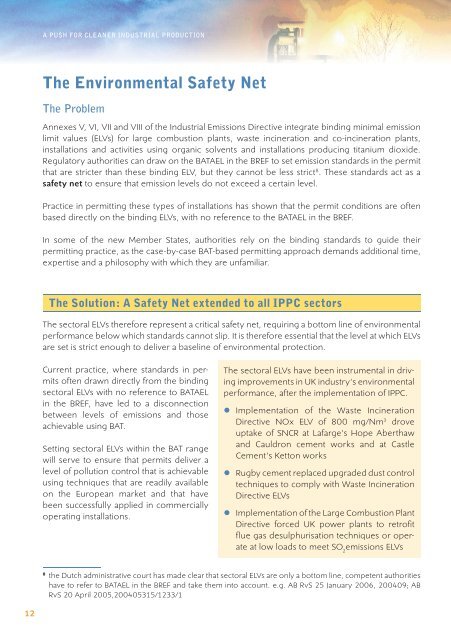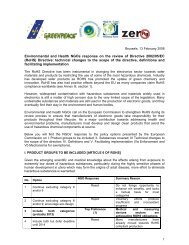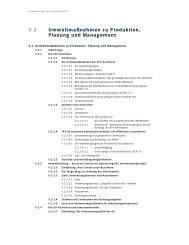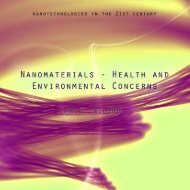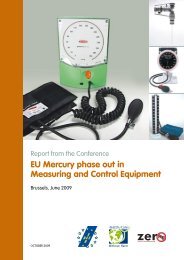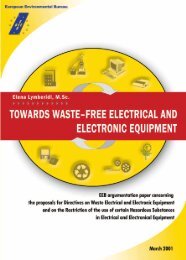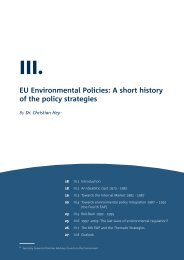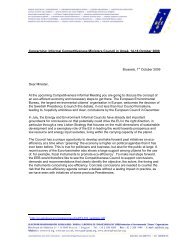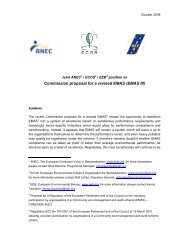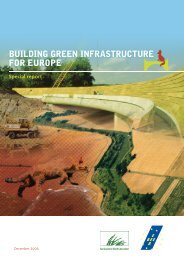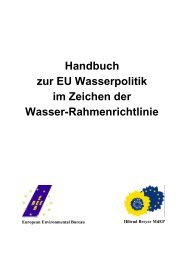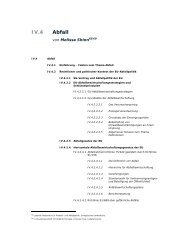A push for cleaner industrial production - EEB
A push for cleaner industrial production - EEB
A push for cleaner industrial production - EEB
You also want an ePaper? Increase the reach of your titles
YUMPU automatically turns print PDFs into web optimized ePapers that Google loves.
A PUSH FOR CLEANER INDUSTRIAL PRODUCTION<br />
The Environmental Safety Net<br />
The Problem<br />
Annexes V, VI, VII and VIII of the Industrial Emissions Directive integrate binding minimal emission<br />
limit values (ELVs) <strong>for</strong> large combustion plants, waste incineration and co-incineration plants,<br />
installations and activities using organic solvents and installations producing titanium dioxide.<br />
Regulatory authorities can draw on the BATAEL in the BREF to set emission standards in the permit<br />
that are stricter than these binding ELV, but they cannot be less strict 8 . These standards act as a<br />
safety net to ensure that emission levels do not exceed a certain level.<br />
Practice in permitting these types of installations has shown that the permit conditions are often<br />
based directly on the binding ELVs, with no reference to the BATAEL in the BREF.<br />
In some of the new Member States, authorities rely on the binding standards to guide their<br />
permitting practice, as the case-by-case BAT-based permitting approach demands additional time,<br />
expertise and a philosophy with which they are unfamiliar.<br />
The Solution: A Safety Net extended to all IPPC sectors<br />
The sectoral ELVs there<strong>for</strong>e represent a critical safety net, requiring a bottom line of environmental<br />
per<strong>for</strong>mance below which standards cannot slip. It is there<strong>for</strong>e essential that the level at which ELVs<br />
are set is strict enough to deliver a baseline of environmental protection.<br />
Current practice, where standards in permits<br />
often drawn directly from the binding<br />
sectoral ELVs with no reference to BATAEL<br />
in the BREF, have led to a disconnection<br />
between levels of emissions and those<br />
achievable using BAT.<br />
Setting sectoral ELVs within the BAT range<br />
will serve to ensure that permits deliver a<br />
level of pollution control that is achievable<br />
using techniques that are readily available<br />
on the European market and that have<br />
been successfully applied in commercially<br />
operating installations.<br />
The sectoral ELVs have been instrumental in driving<br />
improvements in UK industry‘s environmental<br />
per<strong>for</strong>mance, after the implementation of IPPC.<br />
• Implementation of the Waste Incineration<br />
Directive NOx ELV of 800 mg/Nm 3 drove<br />
uptake of SNCR at Lafarge’s Hope Aberthaw<br />
and Cauldron cement works and at Castle<br />
Cement’s Ketton works<br />
• Rugby cement replaced upgraded dust control<br />
techniques to comply with Waste Incineration<br />
Directive ELVs<br />
• Implementation of the Large Combustion Plant<br />
Directive <strong>for</strong>ced UK power plants to retrofit<br />
flue gas desulphurisation techniques or operate<br />
at low loads to meet SO 2<br />
emissions ELVs<br />
8<br />
the Dutch administrative court has made clear that sectoral ELVs are only a bottom line, competent authorities<br />
have to refer to BATAEL in the BREF and take them into account. e.g. AB RvS 25 January 2006, 200409; AB<br />
RvS 20 April 2005,200405315/1233/1<br />
12


